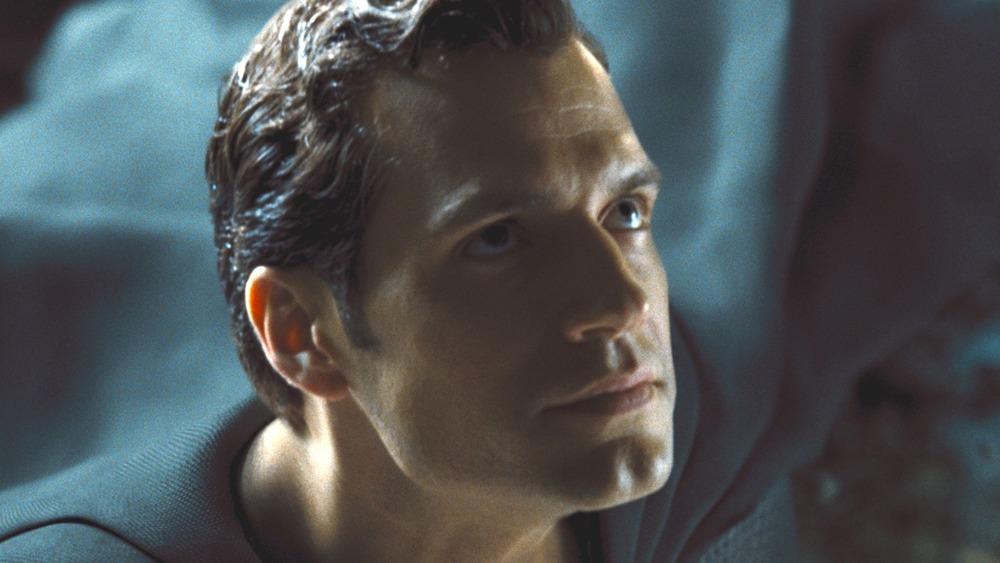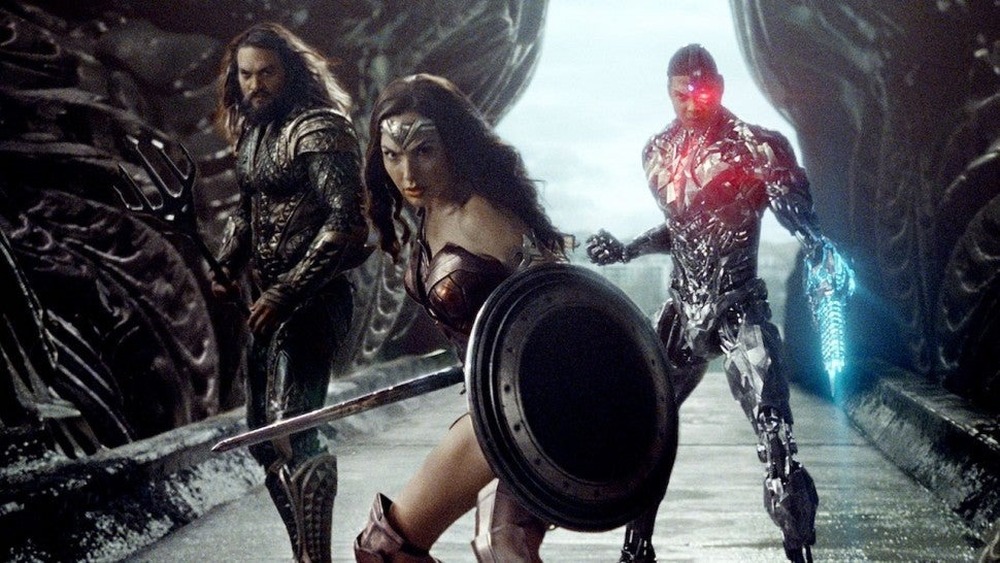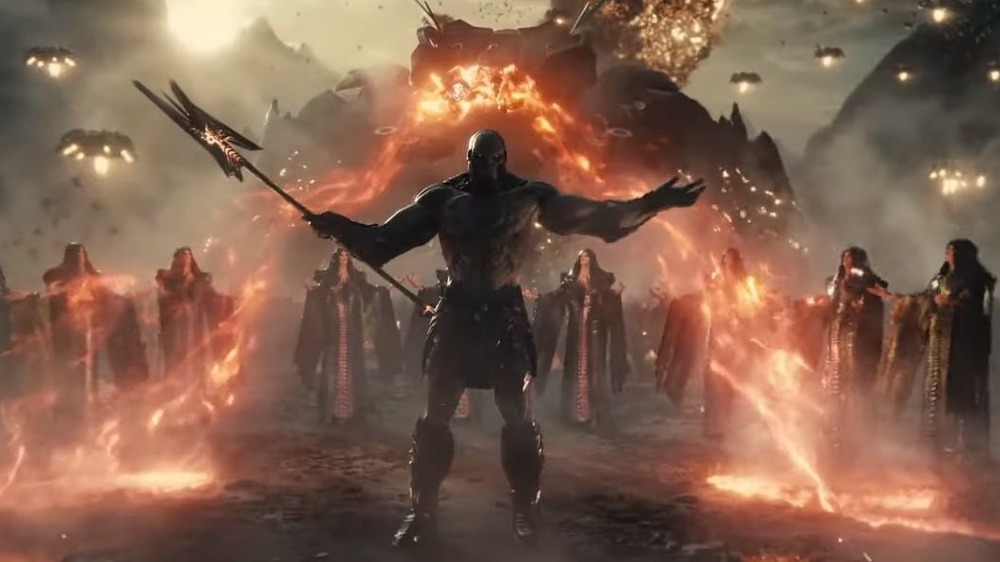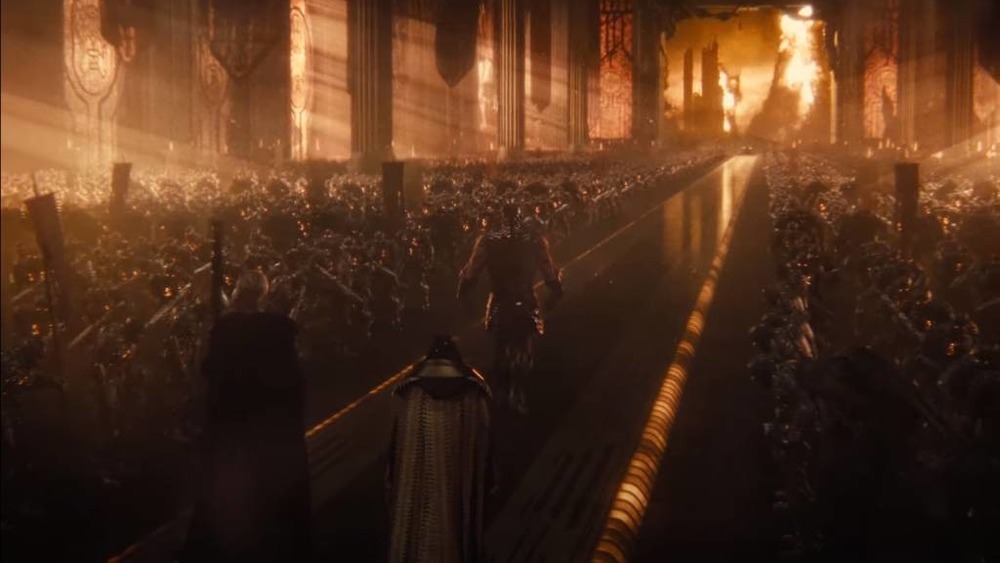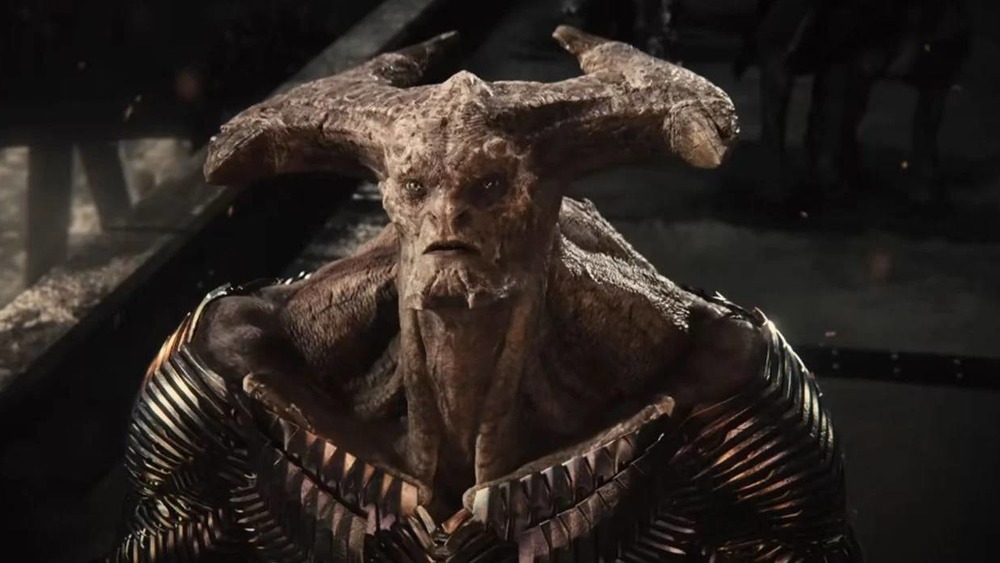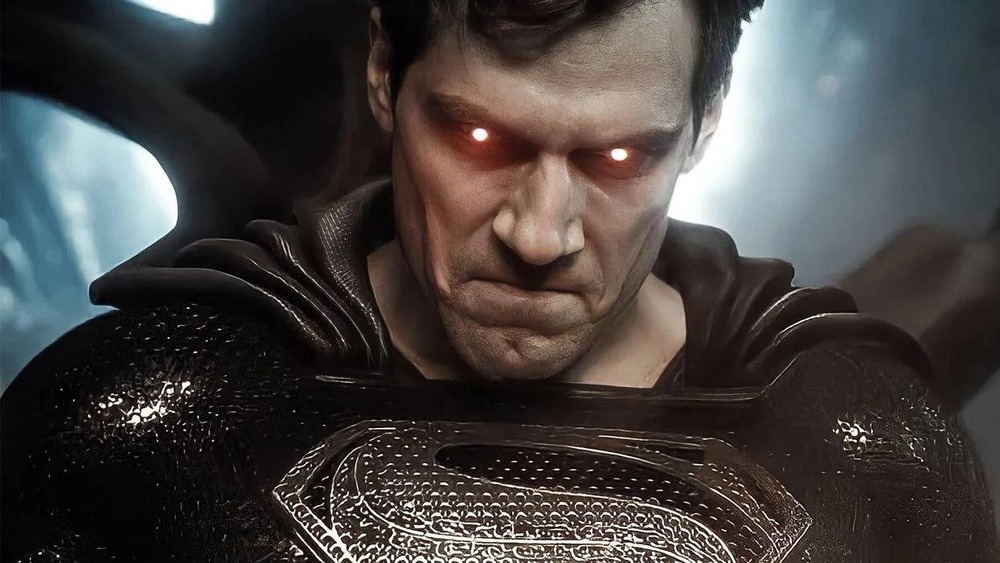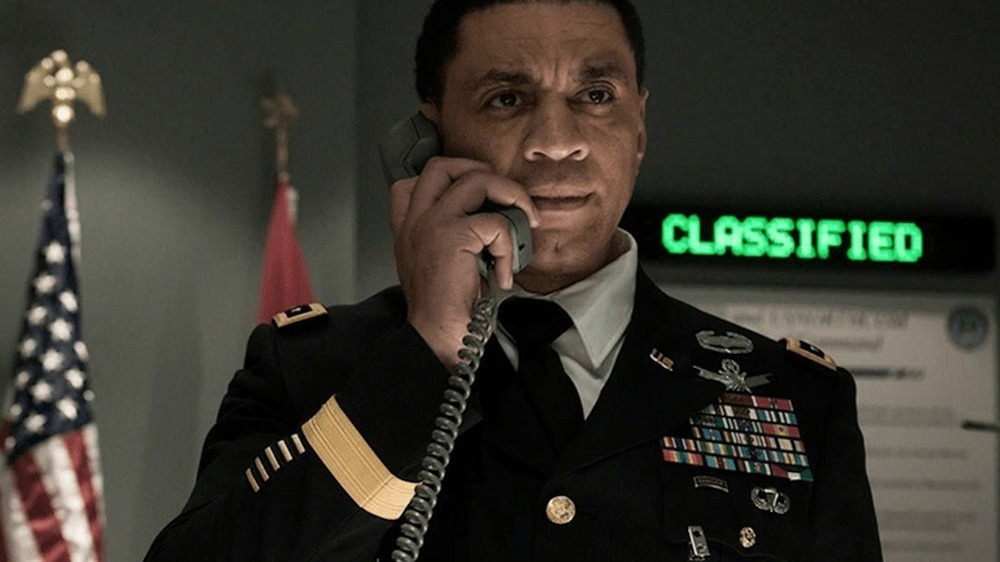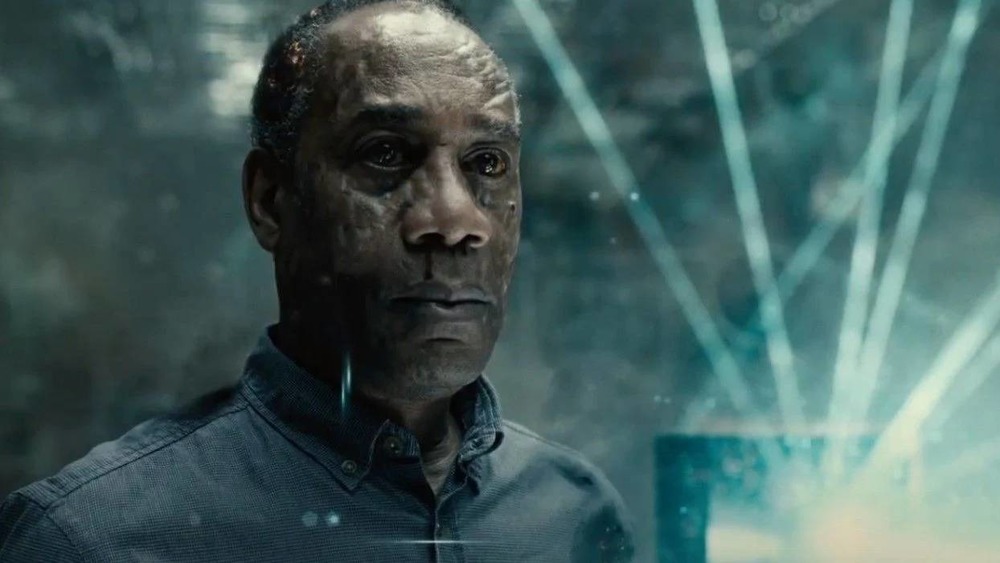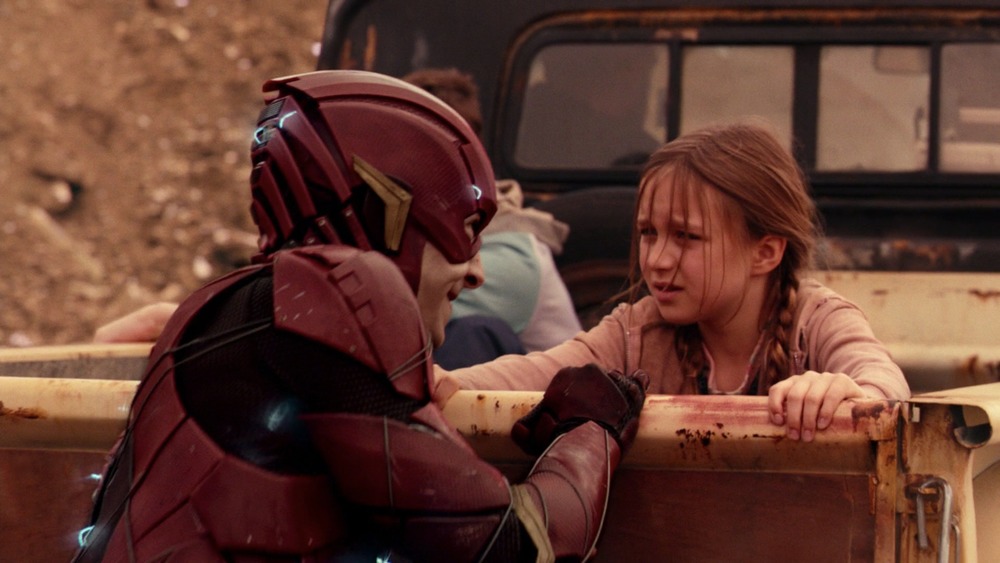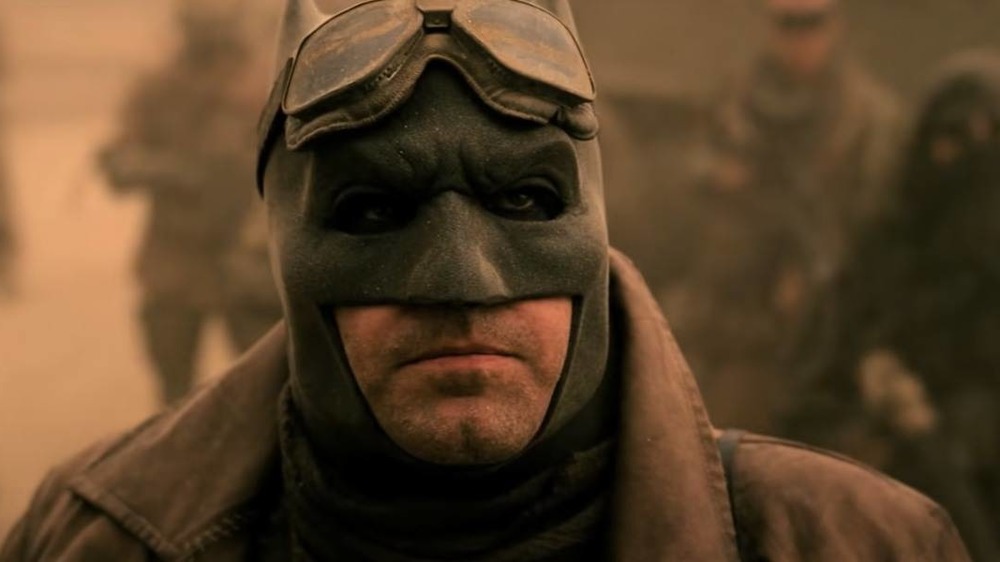The Biggest Changes We Saw In Zack Snyder's Justice League
If you click a link and buy a product or service from a merchant, we may be paid an affiliate commission.
Contains major spoilers for Zack Snyder's Justice League
It's hard to believe the Snyder Cut of 2017's Justice League is a thing that actually exists now. After years of rumors and fan campaigns, the director and the forces over at Warner Bros. have finally unleashed the four-hour epic onto HBO Max. The endeavor wound up being money and time well spent: The general consensus is that the Snyder Cut is vast improvement over the original film, offering a far grittier and more mature version of the superheroes than what fans saw on the big screen nearly four years ago.
The broad strokes are still there. Zack Snyder's Justice League is still ultimately a film following Batman (Ben Affleck) and Wonder Woman (Gal Gadot) rounding up three other super-powered individuals — the Flash (Ezra Miller), Cyborg (Ray Fisher), and Aquaman (Jason Momoa) — as they take on an otherwordly being known as Steppenwolf (Ciarán Hinds) and prevent him from making the planet ripe for Apokolips domination. However, considering the Snyder Cut is double the length of the theatrical one completed by replacement director Joss Whedon, there's plenty of freshness that this version of Justice League has to offer.
Here are some of the biggest changes we saw in Zack Snyder's Justice League.
More backstories
DC took a decidedly different approach when it came to its team-up film than Marvel Studios did with The Avengers. For the latter, the likes of Iron Man (Robert Downey Jr.), Captain America (Chris Evans), and Thor (Chris Hemsworth) got their solo movies before joining forces for the ensemble movie. When it came to 2017's Justice League, only Ben Affleck's Batman and Gal Gadot's Wonder Woman had been previously seen on the big screen. For general audiences not familiar with the comics, it might have been their first time seeing Cyborg, the Flash, and Aquaman in cinematic form. Including three heroes' backstories into one movie isn't easy, and because of that, the theatrical cut of Justice League left a lot of information out.
The Snyder Cut changes that, offering greater insight into the lives of Victor Stone, Barry Allen, and Arthur Curry. We actually get a chance to see Victor Stone before he becomes Cyborg, making good on the footage audiences saw in the original theatrical cut trailer depicting Victor in the midst of a football match. In the Snyder Cut, there's also a sequence of Victor driving home from the big game with his mother. The two end up in a car crash, resulting in Mrs. Stone's death and Victor's eventual transformation into Cyborg. By contrast, the theatrical cut of Justice League offered this information via dialogue.
Flash and Aquaman also get more time in the sun with scenes that would've set up their respective solo movies. (Aquaman's came in December 2018, and Flash is still waiting on his, set to debut on November 4, 2022.) In Zack Snyder's Justice League, Flash gets a scene where he goes in for a job interview when his future love interest Iris West (Kiersey Clemons) ends up in a car accident (a lot of car crashes in the Snyder Cut), and he saves her life. Aquaman gets a scene where he travels into the ocean and speaks with his adviser Vulko (Willem Dafoe), who encourages him to live up to his legacy and save the planet from Steppenwolf.
As a result, these heroes come across as more fully realized, setting the stage for a lot of interesting developments to come in the DC Extended Universe.
More blood, and what that means for one particular character
There's only so much violence you can get away with in a PG-13 theatrical movie, but since Snyder's cut went straight to HBO Max, it wasn't bound by the same restrictions. It's not the bloodiest superhero project put to screen (an average episode of The Boys features more gore), but the violence is definitely more pronounced in the new cut.
Throughout the film, there are moments where a character gets slashed or thrown against a wall, with smatterings of blood added to drive home the point that blows really hurt. One of the places where this is most noticeable is when the Green Lantern known as Yalan Gur attacks Darkseid's (Ray Porter) forces in a flashback sequence. The theatrical cut shows Yalan Gur getting killed in the distance, where you can't really see anything; his death results in his ring floating up in the air. In the Snyder Cut of Justice League, we actually see Yalan Gur's hand get cut off, with the appendage landing right in front of the camera. This allows us to more easily see his ring float away to find someone else worthy of the Green Lantern mantle.
Darkseid and a better look at Apokolips
One of the biggest changes fans were looking forward to seeing in the Snyder Cut is the introduction of Darkseid into the DCEU. The theatrical cut of Justice League puts the antagonistic focus on Steppenwolf, who only casually mentions Darkseid in passing. Things obviously play out differently in Zack Snyder's Justice League, which is no surprise considering how frequently and heavily Darkseid was teased in the film's trailers. Audiences will pick up on a standout change during the flashback when the forces of mankind, Atlantis, and Themyscira prevent the three Mother Boxes from forming the Unity. 2017's Justice League shows Steppenwolf being the one to lead this charge, but in Snyder's version, Darkseid actually steps foot on Earth, setting him up as the big bad he was supposed to become in the films.
The Snyder Cut also contains a scene in which Darkseid communicates with Steppenwolf in the middle of his master plan, as well as another moment where Darkseid comes face-to-face with the Justice League through a portal, where we get our best look yet at Apokolips. Darkseid stands among DeSaad (Peter Guinness), Granny Goodness, and legions of Parademons as he makes it clear he's ready to take the battle to Earth personally to ensure his will is done.
The set-up for the Anti-Life Equation
As anyone who has followed the Snyder Cut saga can tell you, the director had big plans for the DCEU going forward, and Justice League was supposed to set up the direction these movies would take in the future. Steppenwolf was intended to be merely a harbinger of what was to come, and Darkseid wreaking havoc on Earth was on the horizon. Zack Snyder's Justice League shows precisely how the supervillain would make the Knightmare world a reality.
At one point in the film, Steppenwolf communicates with his master about how he's discovered the Anti-Life Equation is on Earth. This is a mathematical formula from the pages of DC Comics; it instills hopelessness, fear, and despair in sentient life forms, allowing them to fall under the control of whoever gave them the equation. Darkseid is often associated with this concept, and even though the Mother Boxes were destroyed, he can still use the Anti-Life Equation to gain control of humanity.
With this mention, it's easy to speculate as to where Justice League 2 (as directed by Snyder, anyway) would've taken us. More than likely, Darkseid would have gone to Earth himself and gained control of the Anti-Life Equation, likely using it on Superman to do his bidding. This would explain why the Man of Steel attacks Batman and his allies in the Knightmare timeline. How would Batman and the gang have reversed course and saved the world from such a horrific fate? That may be something that's permanently left in the wind, particularly considering the fact that Snyder himself has said he wanted to end his cut of the movie on a cliffhanger despite no sequel being in the works.
Superman gets a new suit
In the Death of Superman comic book arc from 1992, Clark Kent returns to the world of the living with a spiffy new outfit: a black suit that's pretty perfect for the edgy early '90s. Considering Batman v Superman: Dawn of Justice closely followed that comic storyline, with Superman meeting his end at the hands of Doomsday, many fans naturally expected him to don the black suit when he was inevitably resurrected in Justice League. But when the film came out in 2017, the Kryptonian had his signature blue and red suit the entire time (when he wasn't shirtless, of course).
Zack Snyder's Justice League rectifies this issue by having Clark dress in all black. After he reunites with his adoptive mother Martha (Diane Lane) back in Smallville, Clark goes back to the Kryptonian ship and stumbles upon a suit that looks like it came from Krypton's answer to Hot Topic. He promptly soars into outer space to look at the sun for a moment before lending a hand to his fellow heroes.
He's not just showing off in this moment either. In the comics, Superman's black suit is also referred to as the "regeneration suit" because the suit's dark color makes it easier for him to absorb the sun's rays, which give him his powers and heal him. While it's never explicitly stated, that's likely what Superman did in the director's cut of the film: slipped into his black suit and received a boost of energy so he could help take down Steppenwolf.
The arrival of Martian Manhunter
As anyone who watched the Justice League cartoon series in the early 2000s can tell you, there was one member of the team who was conspicuously absent in 2017's Justice League. J'onn J'onzz, aka Martian Manhunter, was nowhere to be found. His lack of presence was even more confusing when remembering that a lot of marketing in the lead-up to the film involved the phrase "Unite the Seven" (via CBR). This seemed to be a reference to the seven traditional members of the Justice League, one of which is Martian Manhunter, so when only six superheroes ended up in the movie, everyone was sufficiently puzzled.
Zack Snyder's Justice League fixes this by giving us a solid look at the Martian. As it turns out, he's been among humanity for a while now. It appears as though he's been assuming the identity of Lieutenant General Calvin Swanwick (Harry Lennix), who was first introduced in Man of Steel.
In the HBO Max exclusive, all is revealed — albeit ever so briefly. Martian Manhunter first appears after assuming the form of Martha Kent and speaking to Lois Lane (Amy Adams) to encourage her to go visit Clark's memorial. The Martian sits out of the big fight in Zack Snyder's Justice League, but the final scene of the film shows him paying a visit to Bruce Wayne, letting him know another battle is on the horizon and that, when necessary, he'll show up again to help out. Much like the mention of the Anti-Life Equation, this appears to be a set-up to a sequel that probably won't ever come to fruition, but with any luck, a Martian Manhunter solo movie will one day be made.
Silas Stone's heroic sacrifice
When it comes to getting the last Mother Box, in the theatrical cut of Justice League, Steppenwolf just kind of ... grabs it while no one's looking. It's a bit anticlimactic, and now, we see why. Snyder's version of the movie contains an additional sequence showing Cyborg's father, Silas Stone (Joe Morton), trying to prevent Steppenwolf from getting his hands on the last Box. The only way he knows how to do this is by trying to destroy the Box, requiring Silas to give up his own life to try to save humanity.
He carries out this plan in front of his son's eyes, and all Victor can do is stand there helplessly, losing his father so shortly after his mother died. This sequence demonstrates the fact that while Silas may have been obsessed with his work, he still clearly loved his child very much, going so far as to die so that Victor could live. It offers some much-needed poignancy and closes out the character's arc, whereas the theatrical version of the movie simply had Silas disappear after a little while without much explanation.
No more Russian family sequence — Barry's got something bigger to do
In the midst of the final battle between the Justice League and Steppenwolf in the theatrical version of the film, we take some time away from the fight to watch as Flash saves a Russian family. After viewing the Snyder Cut, it's easier to understand why this rescue scene felt so tacked-on, especially when there was much more that Flash could've done to help his comrades in those moments.
Evidently, Whedon must have shot that sequence entirely during reshoots because the Russian family doesn't appear anywhere in the Snyder Cut. Instead, Flash spends time in the final fight trying to charge up enough to give Cyborg the boost he needs to eliminate the Mother Boxes. When he fails, the speedster manages to run so fast that he's actually able to travel back in time and give Cyborg the power he needs in the past, giving the heroes another chance at defeating Steppenwolf right then and there.
There may not be as much of an emphasis on saving civilians in the Snyder Cut of Justice League, but it's clear the director had something else in mind. In establishing Flash's time-travel ability, Snyder was likely trying to set up the solo Flash movie, which has long been rumored to adapt the Flashpoint story line from the comics. This arc sees Barry Allen travel back in time to save his mother's life, causing drastic changes to the timeline where Bruce Wayne was killed as a child and Themyscira and Atlantis are at war with one another. It's anyone's guess as of right now whether that's what the Flash movie will be about, but it seems to be yet another example of the grand ideas Snyder had for the DCEU as a whole.
Batman swears (oh, and the Joker shows up)
Fans knew for quite a while before Zack Snyder's Justice League debuted on HBO Max that the movie would include the Joker as played by Jared Leto in Suicide Squad. It's one of the few scenes the director filmed specifically for the HBO Max exclusive to give the two comic book icons a chance to actually interact. However, no epic battle of fisticuffs ensues; instead, Snyder does something a lot more interesting by having Batman and the Joker engage in a conversation about how much destruction each one has caused. Joker in particular tries to push at Batman's buttons by bringing up the deceased Robin, but the Caped Crusader fires right back at him by mentioning how when Harley Quinn died in his arms, he promised her that he would kill Joker slowly when he finally got the chance to murder him.
This is the moment where we get that mythical F-bomb Snyder had been teasing in relation to how much edgier his cut of the film would be compared to the original. Batman tells Joker, "When I held Harley Quinn and she was bleeding and dying, she begged me, with her last breath, that when I killed you — and make no mistake, I will f***ing kill you — that I'd do it slow." Clearly, this isn't your grandfather's Batman who would beat up bank robbers with a "pow!" and "zop!" in the background. He's rough around the edges and has a colorful, cutting way of speaking.
Everything considered, Zack Snyder and the executives at Warner Bros. obviously had very different ideas around 2016 and 2017 about what a Justice League movie was supposed to be. At least now, Snyder's vision is out there in the world, and the one thing it's likely to have in common with the 2017 version is that fans will continue to discuss it for years to come.
